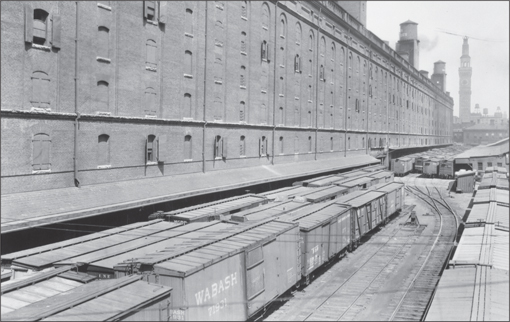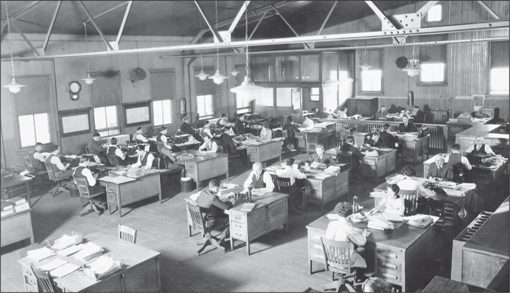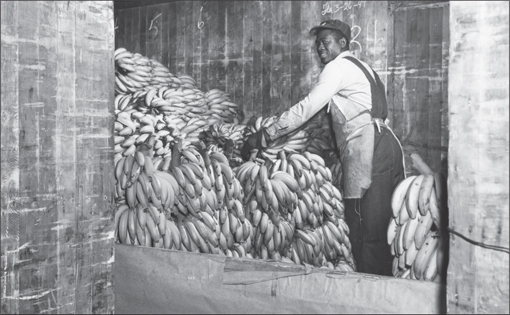Six
THE END OF AN ERA
1928–1986
From 1928 to the end of the B&O in 1987, the railroad faced significant challenges that mirrored the railroading industry. The first was the Great Depression, which forced changes in operations, layoffs, and increased competition. World War II created a brief resurgence due to the increased freight and passenger traffic related to the war effort. However, postwar challenges due to regulation and the increased use of trucks, automobiles, and airplanes siphoned off business, and the railroad began a rapid decline in the 1950s.
It was during this period that the railroad began transitioning to diesel power. The B&O began by adding a box cab switcher as early as 1925 and introduced No. 51, the B&O’s first streamlined diesel engine, to pull the Royal Blue in 1937. The B&O was slow to transition to diesel technology due to labor opposition, implementation costs, and World War II’s demand for any and every available engine, which extended the life of steam power. The Mount Clare Shops built its last steam engine in 1948, and by 1960, the B&O no longer operated steam on its line.
Following the war, passenger service entered a period of decline, as people relied more heavily on other forms of transportation that were often speedier and less costly than rail travel. Passenger service on the main line ended in the late 1940s, and service was reduced, eliminated, or modified on many B&O routes. Many stations closed their doors or served as freight-only terminals. The railroad would shed its passenger service completely in 1971 with the creation of Amtrak.
By 1963, financial losses proved too much for the B&O, and it merged with the Chesapeake & Ohio Railway. While maintaining separate corporate identities, change was in the wind, and B&O no longer controlled its fate. Merging again with the Western Maryland, the three entities would be known as the Chessie System in the early 1970s. Ultimately, they would merge with Seaboard and create CSX. The B&O would formally cease to exist in 1987.

This interior view of the switching tower at Camden Station shows the telegrapher (rear) and the switchman, who hand-operated the switches necessary to maneuver trains in, out, and around the crowded stretch of tracks. Switching towers were efficient ways to change track alignments and allowed one individual to align tracks in a central location, rather than on the ground directly next to individual switches.

Freight cars wait for loading and unloading on the eastern side of the B&O’s Camden warehouse. The tracks were frequently packed at this busy hub. In the distance is Baltimore’s famous Bromo Seltzer Tower. The top of the tower contained a blue bottle of Bromo-Seltzer, which was removed in 1936 due to structural concerns. Like the warehouse, both structures still exist and are local landmarks.

These photographs show the B&O Railroad’s tobacco warehouse at Henderson Wharf on the Fells Point waterfront. Designed by Ephraim Baldwin, it was completed in 1898. It was six stories high and had the capacity to hold the contents of 500 freight cars. Southern tidewater tobacco was brought to the warehouse for classification and sorting prior to being sent to European markets. Kelly-Springfield rented the building for tire storage, and it was used to store other wares, including whiskey, into the 1970s. The above photograph shows the western side of the building as seen from the water. The photograph below, taken from the street side, is from the early 1930s. On the far left is the No. 10, an electric engine used to move boxcars for 45 years. The warehouse is now home to an inn and private condominiums.


Shown here are contrasting views of the Camden warehouse operations. Above is a 1930s interior view of the freight offices of the B&O, housed in the upper floor of the warehouse. Below are hundreds of barrels of rye whiskey awaiting shipment. Since the earliest days of railroading, hauling freight has always been the main money-making venture of railroads. The warehouses held every kind of product shipped by the B&O. Operations like these were significant, financially lucrative, and helped make the port of Baltimore a major business hub.


Pictured here are two envoys from the emperor of Abyssinia (modern-day Ethiopia). On the far left is Kentiba Gabru, and on the steps of the President Arthur, dressed as a fireman, is Malaku Bayen, a relative of the emperor. Both men rode the Capitol Limited from Washington, DC, to Baltimore’s Mount Royal Station on August 27, 1930.

The B&O used window displays at Hochschild Kohn & Company’s Baltimore department store to promote its history and services. This May 1931 display was used to promote the comfort and amenities of the B&O’s new passenger coaches. The coaches featured individual wall lights for night reading, window ventilators that allowed fresh air to come in without the dust, and reclining passenger seats with footrests.

A passenger train pulls past HX tower in Halethorpe, Maryland, in November 1938. The tower was built in 1917 and served the bustling site of the Fair of the Iron Horse during the 100th anniversary celebration in 1927. It controlled southbound and westbound traffic along the main line. Located just east of Halethorpe Farms Road, the tower closed in 1985.

This iconic image of B&O crewmen appeared in B&O’s magazine in October 1930. Shown here are, from left to right, conductor C.J. Welch, brakeman Mort Yarnell, and baggage man Roy Durrett. Taken in Grafton, West Virginia, the image is included here because the crew operated between Grafton and Cumberland. The magazine marveled, “They make traveling between Cumberland and Grafton a pleasure all the time.”

Passengers waiting to board B&O trains spend their time relaxing in Mount Royal Station. With high ceilings, large windows, ornate columns, marble floors, a fireplace, and incredibly comfortable rockers, the station could boast a beautiful decor. Service at the station ceased in the early 1960s. The building was saved from demolition and decay when it was sold to the Maryland Institute College of Art in 1964 for $250,000.

A brakeman handles a 50-ton coal hopper in the Cumberland classification yard. Brakemen had very dangerous jobs, riding railcars and adjusting hand brakes in all types of weather. While air brakes helped make this less necessary on main line service, brakemen still rode cars in hump yards as the freight trains were broken apart and reformed. Here, the brakeman inserts a bat in the hand brake for more leverage.

The above photograph of Locust Point shows the bustling facility in the 1930s. In the distance is the industrial, business, and commercial center of Baltimore. In the foreground is Fort McHenry. The bombardment of the fort by the British in September 1814 served as the inspiration for Francis Scott Key to pen “The Star-Spangled Banner.” In addition to people, grain, coal, ore, and bananas were loaded and unloaded at Locust Point. Below, a worker unloads at the Locust Point fruit pier. The Locust Point operation prepped refrigerator cars and loaded barges that traveled to Pier No. 1, located in Baltimore’s Inner Harbor (known as the basin). The B&O operated a special train between Baltimore and Toledo, Ohio, that would run any day it had 25 cars to move.


This aerial photograph of the Brunswick classification yards shows the incredibly large operation that stretches seven miles along the banks of the Potomac River in Frederick County. Opened in 1890 to ease crowding of the Martinsburg rail yard in West Virginia, the yard and facilities provided the space needed for breaking and building freight trains and for servicing engines. The geography was ideal for rail operations, and the land in the area was relatively cheap. The yards are still in use today.

Silver Spring, Maryland, has been home to two B&O passenger stations. The first, constructed in 1878, is pictured above in the late 1930s. This two-story, High Gothic structure was designed by Ephraim Baldwin and was similar to the 1873 station built in Rockville, Maryland. The location of the station was, in part, determined by the efforts of Washington newspaper editor Francis Blair, who advocated the site based on early surveys of an uncompleted rail line. Below is the modern station, built in 1945. It replaced an existing 1878 station, and it was constructed directly on the foundation of the earlier building. Built in the Colonial Revival style from standardized station plans, the brick structure contained a waiting room, baggage room, and offices. The main station is owned and managed by Montgomery Preservation, Inc.


The Royal Blue heads to Washington, DC, over the Thomas Viaduct in the late 1940s. The streamlined locomotive is the Pacific class No. 5302, the President Jefferson. Built in 1927, it was streamlined in 1946 and retired in 1956. Like most of the presidential steam engines, No. 5302 was scrapped. In the distance is the Relay Hotel.

B&O SW-1 Switcher No. 208 pulls freight cars down Eutaw Street on the western side of the B&O freight warehouse in the 1940s. Construction of the warehouse began in 1898, and the last sections were completed in 1905. The eight-story building is over 1,000 feet long and 51 feet wide. The warehouse was saved from demolition when it was incorporated into the design for Oriole Park at Camden Yards.

This map shows the extent of the B&O Railroad in 1954. It would be nine short years before the decline of the B&O picked up speed. Facing mounting financial shortfalls and declining business due to regulation and competition with trucks and airplanes, the B&O came under the control of the Chesapeake & Ohio Railway in 1963. While the two railroads maintained separate identities, mergers with the Western Maryland Railway created the Chessie System in 1972. Eventually, in 1987, the Chessie System merged with Seaboard to create CSX, and the B&O Railroad ceased to exist after 160 years.

A group of children gathers at the St. Denis station just outside Baltimore. The building, a simple Baldwin design, was typical of many of the standardized structures erected by the B&O in the late 19th century. Built in 1891, it burned down in 1976. A small shelter serves as a commuter stop on the MARC system where this station once stood.

Fearless Williams worked for the B&O Railroad from 1906 to 1952. He began as a floor porter at the General Office building. His dedication and abilities helped him earn a position in the president’s office in 1916, where he served until he retired at the age of 70. He was active in Baltimore’s African American community and was the maternal uncle of Supreme Court justice Thurgood Marshall, who also briefly worked for the B&O.

The B&O ran seasonal excursions to western Maryland to support the region’s tourism. Here, a crowd gathers at the Oakland station to welcome visitors during the Autumn Glory Excursion on October 5, 1952. The excursions departed from Camden and Silver Spring, and buses provided transportation to local attractions and state parks before returning visitors to their point of departure. These trips allowed visitors to enjoy the crisp temperatures and beautiful scenery.

Lawrence Sagle (right, in hat), of the B&O’s public relations department, accepts a certificate commemorating the 125th anniversary of Peter Cooper’s Tom Thumb from Allan Constance (far right) of the Baltimore Society of Model Engineers. The presentation took place in 1955 on a trip down the main line during the Baltimore Convention of the National Model Railroad Association. Sagle would later head the B&O Transportation Museum.

The B&O dining car department operated a cafeteria on the 12th floor of the Central Building in Baltimore. In 1959, the cafeteria served an estimated 500 people every day. The facility operated from 7:30 a.m. to 8:30 a.m. for breakfast and from 10:30 a.m. to 2:30 p.m. for lunch. Helen Schubert serves coffee to Henry Horn, from the freight traffic department.

The B&O employed one of the latest innovations for car reporting in March 1959. The railroad introduced a system known as “D-O-T,” or Data-on-Tracing. The system used punch cards to represent freight trains on the rails. That information was translated to teletape and sent by Teletype to the B&O’s Baltimore nerve center. Here, Joan Bartenfelter supervises transmission of car information from tape to punch cards.

Guarding the railroad was a full-time job, and the B&O had its own dedicated police force. Pictured here are members of the B&O’s Brunswick Police Department. Seated at center is Lieutenant McGaha. Standing are, from left to right, road patrolmen B.B. Burch and W.A. Cage; patrolmen W.D. Horman and W.R. Donovan; and relief men H.F. Carey and P.F. Weitzel.

A B&O tugboat pushes a barge loaded with refrigerator cars into position near Baltimore’s Inner Harbor. The United Fruit Company was located on Pier No. 1, where boats carrying bananas were unloaded and the produce transferred to the refrigerated boxcars. The B&O used barges to transfer the reefer cars from Locust Point to the Pier No. 1 facility for loading and unloading and then back to Locust Point for transfer and distribution by train.

The B&O’s Cumberland facilities were important for rail operations for freight as well as passenger service. Initial freight operations were located near the Queen City Hotel and station. As freight traffic grew, it became necessary to expand the operation to include a larger classification yard and hump operations. Here, a B&O SD-9 roadswitcher works the yard in the late 1960s.

B&O biochemist Carl Webster (seated) and Earle Heinbaugh test springwater for chlorine content near Deer Park. Land near the B&O’s hotel contained a freshwater spring that was a source of clear water. The B&O bottled the water and used it for hotel guests and on its passenger trains. The railroad sold the spring in the 1960s to a company that continues to produce Deer Park water today.

Visitors wait to board a train to Baltimore after visiting the B&O’s Holly Tree along the tracks near Jackson, Maryland. The B&O purchased the tree, and volunteers decorated it annually. Lighting the tree became a seasonal event. As many as 55,000 people visited the tree during the holiday season, and countless travelers saw it as they passed by on B&O trains.

This image shows Baltimore’s changing landscape, as redevelopment of the Inner Harbor begins in the 1970s. This area, located at the corner of Pratt and Light Streets, would become a collection of shops and restaurants known as Harborplace. To the left are Pier No. 1 and the USS Constellation. The pier was once home to B&O barges that served the operations of the United Fruit Company.

Designed by B&O architects Ephraim Francis Baldwin and Josias Pennington and built in 1884, the Oakland station was one of many significant improvements along the B&O line in the 1880s. Designed with two separate waiting rooms and a ticketing area, the building’s Queen Anne style is symbolic of the B&O’s efforts to upgrade its existing stations. It served the resort area of western Maryland and still stands today. Efforts are under way to open the site as a museum.

The MARC commuter station at Dickerson, Maryland, is a reconstructed version of the B&O station built in the 1890s. It was named for William Dickerson, who built a general store to serve the railroad contractors working on the line nearby. It was partially destroyed by fire in the 1970s and restored to its current appearance.

































